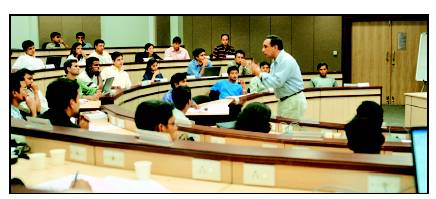Think about the situation where the student gradutes from an institution with a salary higher than its director’s; that is what happening in Indian Institute of Management (IIM). The student is offered a lucrative pay package and looks forward to annual promotions and increments. Now turn your focus to the teacher who moulds those students. Are the teachers satisfied with what they are? What is going to be the future of teaching profession in graduation and post graduation levels?
Importance of teachers
On an average, a student in high school or in graduation spends about 6.5 hours with the teachers. This reduces to 5 hours in post graduation level. This itself explains how much a teacher can influence the student. The future of every country depends on its young generation who are moulded by the teachers. Even though factors like Television and Internet are having a great (positive/ negative) impact on youngsters, the teachers can direct the young potential of India to the economic development and welfare. Teachers are the key for national development. The students believe their teachers much more than their parents!
Teaching profession
We (Indians) are having a very great history in teaching profession, which goes back to the old guru-shishya days of teaching methodology. Those days, the teachers were the epitome of knowledge and wisdom. They shared their knowledge to those who seek; not because of any resultant benefits, but out of passion to make the world rich in knowledge. Coming to 2008; what is happening over here? There are only a few, very few who shares their knowledge out of passion. The majority of teachers consider teaching as a ‘job’ or a ‘profession’.
We are having a great number of teachers. But how many of them are competent enough and have the real ‘thrill’ in sharing knowledge? We are lacking quality faculty, especially in graduation and post graduation levels. It is a hard fact that India is a lagging indicator of U.S in different aspects. 60% of IT jobs in U.S are outsourced to India. So atleast a part of India is also turning to U.S lifestyle. What is happening in U.S may reflect in India in the near future. Like U.S, India may face a crunch in quality faculty in higher education in the coming years, unless necessary actions are taken. There are many foreign firms who are ready to pay lucrative salary even for those who are not as competent as teachers. Then why should the teachers stick to their profession?
Challenges
According to UGC report(2007), the total number of teachers in India is 4.88 lakhs. Out of which almost one-fourth positions are vacant. There is no proper mechanism to evaluate the number of faculty available in colleges and are required in colleges. Measurement is the key towards achieving quality. But what if there are no accurate figures?
The ratio of teacher to students is increasing. This is either due to the increase in number of students for a particular course, keeping a less increase in number of teachers or due to the decrease in number of teachers keeping the student numbers as constant. Most of the business schools are having a faculty to student ratio of greater than 1:50. A teacher is handling a class of 60 sutdents in a post graduation level. How feasible is this while considering the real learning? I am wondering whether the b-schools are business schools or schools for business! In a PG class, the teacher to student should be around 1:30 for better discussion and interaction.
Another problem is lack in competency among teachers. Those who are doing quality research work are not getting much recognition. This results in decrease in number of teachers doing research work. Also the UGC’s policy of promotion is an obstacle. A person is automatically promoted to the next higher position after the completion of a fixed number of years. These factors results in less competency among teachers.
And obviously the pay package. The salary package of teachers are not attracting much talented people into the teaching profession. Most of the students opt for a management education after their graduation rather than pursue a PhD. What is the use of spending years pursuing PhD when the students can earn more after an MBA? ( Here only salary factor has been considered. But there are more factors like technological addiction, work life balance etc. play a crucial role in pursuing a PhD and a career thereafter)
Solutions
It is time to come up with innovative approaches in enhancing the quality of faculty in graduation and post graduation(PG) levels- in IITs, IIMs, other higher education institution etc. Otherwise the losers are none other than ourselves. India is going to loose in the long run.
Below points focus on some of the basic suggestions:
Most of the teachers who start their career in PG level teaching are in their middle age(for statisticians: they follow a normal distribution with 2sigma). So the importance should be given to salary and work-life balance.
- Provide reasonable and better pay package.
- Enhance a work culture than balances work and personal life.
- Promotion and Increments should be given on a competency basis.
- Due recognition and incentives for those who are doing quality research work and there by promoting research work.
- International exposure through foreign University tie ups- atleast six months to one year teaching in a foreign University during a period of 5-7 years.
- No compromise on quality. Compromise on anything leads to degradation of quality.
- The most important is continuous evaluation of teachers. It should be a 360 degree evaluation. How many schools/colleges are evaluating the teaching methodology of a teacher in a class? Are they bringing any new and innovative changes in the teaching methodology according to current situations?
You can also contribute some innovative ideas. Please comment your ideas/suggestions to improve the faculty quality in higher education.
